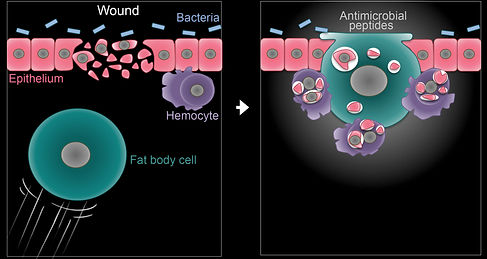



Anna Franz lab
Motile adipocytes in wound healing and cancer

Fat body cells in wound healing
Adipocytes, also commonly known as fat cells, were once believed to merely serve to store our energy and keep our bodies warm. It is now clear that adipocytes also play other diverse functions ranging from systemic metabolic and immune regulation to key functions in tissue development and cancer progression. However, little is known about the roles of adipocytes in wound healing, the process through which the skin restores its tissue integrity and prevents pathogen invasion following injury.

Fruit flies have adipocyte-like cells called fat body cells that are best known for their many systemic roles regulating metabolism, growth and immunity. We recently discovered that fat body cells are not immotile, as previously presumed, but are highly motile cells that actively migrate to skin wounds. Once at the wound, fat body cells play several local roles in wound healing. They tightly seal the wound gap and release antimicrobial peptides to reinstate a physical barrier and thwart infection. Moreover, in collaboration with hemocytes (fly macrophages), they clear the wound of cell debris to enable wound repair.
Building on this previous work, we are currently investigating the local and systemic functions of fat body cells in wound healing using sophisticated genetic, molecular and live imaging techniques.
Movie showing fat body cells migrating to a wound (fat body cells in green and nuclei of the epithelium in red)
Movie showing hemocytes and fat body cells migrating to a wound (hemocytes and fat body cells both in green and red)